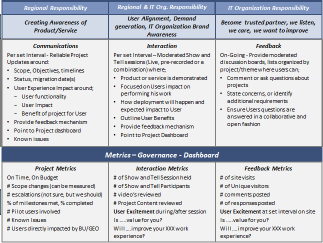Insight Paper May 18, 2013
IT Project Delivery
On Time, On Budget? Not Enough!
Historically, the success of an IT project has been based in whole or in part on the premise of delivering a product or service “on time and within budget”. While we all understand these are important measurements, there is a paradigm shift occurring towards an extended set of success criteria for IT projects. These new criteria go beyond the traditional and often myopic IT view of the corporate business, demonstrated by the limited understanding of Business User job demands, and lack of regard for job stressors and job performance enablers. This is nothing new if the role of IT is to provide the infrastructure, platforms and services needed for Business Users to execute their jobs as efficiently as possible in order to drive company value. But, in today’s environment, where more and more IT projects need to be delivered in a shorter amount of time to realize the business benefits quicker, and where less resources are available, we all too often ignore the importance of Business User involvement during the IT project cycle.
Trexin is a strong proponent of an IT organization that supports and promotes employee engagement (see Enhanced Project Success Model (1) ). Engaged users:
- Show an increased satisfaction with ITProject Success Model
- Are more likely to provide pro-active feedback
- Show more support for the IT initiative with less complaints and management escalations
- Ultimately give IT higher marks for service excellence
All of which may have a positive influence on IT leadership’s ability to obtain sponsorship for new projects, obtain IT budgets and improve their image throughout the business.
The Gallup organization states:
“Employee engagement or the ability to capture the heads, hearts, and souls of your employees to instill an intrinsic desire and passion for excellence. Engaged employees want their organization to succeed because they feel connected emotionally, socially, and even spiritually to its mission, vision and purpose.”

The top three drivers for Increased Business User Satisfaction (2) are User Involvement during the development or project initiation phase, Perceived Usefulness of the service/platform, and User Experience. What is surprising in all of this is not the outcome of the research, but that this information is not part of a structured methodology embedded as part of the PMO/IT process models. It is seen as cumbersome, time-consuming, and often the Business User knowledge is regarded as ‘how would they know what is best for them’. To be sure, User Centered Design (UCD) , User Experience (UX), and Agile, just to name a view are often times seen as too complicated, or time-consuming to use – our real world model is based on being ‘Useful, Usable and Used in the field’.
Should a PMO have an Business User Experience Governance model whereby the chief function is to ensure the Business User is actively engaged, has an open and constructive dialogue, where concerns are addressed, and communications are concise, relevant and taken seriously? All while collecting relevant metrics? I strongly believe the answer is Yes!
By adopting a common Business User communication framework that incorporates corporate communications, ensures a proactive end-user reach out, and enables a transparent feedback mechanism in a social forum format so that questions and answers can be seen by all, the Business User is optimally engaged in the IT development process. Our Business User inclusion framework is an interactive communication model that can easily be adopted to drive enhanced Business User satisfaction for IT delivery projects:
“IT will play an even bigger business-focused role for digital data, e-commerce, business automation, etc” -CIOinsight – IT Growth Outlook and Trends 2013.

Conclusion
Despite resource constraints, and management pressure to deliver IT Projects quicker and leaner, it would best serve the business and IT to include the Business User in all IT projects where there is a Business User impact. By increasing Business User buy in and support, IT’s standing will increase and over time, so will needed budgets and resource allocations. This alignment and the now inherent mutual understanding of business user needs and IT’s capabilities might even slow down or eliminate business users looking to engage with 3rd parties to get what they want quicker and (often) better. Business User inclusion can be jump-started by implementing the Trexin Business User Communications Framework to help drive business and IT value across the organization.
Spread the word!
(1). Source: extension of DeLone & McLean 2003, p. 24- and enhanced by Trexin
(2). Reference: Adam Mohmood, M., Burn, J. M., Gemoets, L. A., & Jacquez, C. (2009). Variables affecting information technology end-user satisfaction: a meta-analysis of the empirical literature. International Journal of Human Computer Studies, 52(4), 751-771


